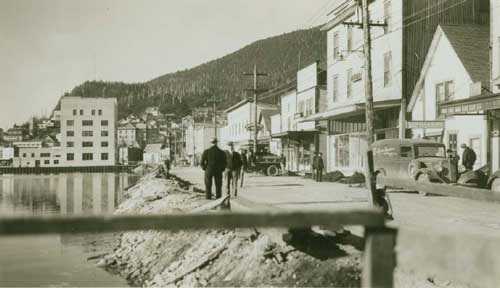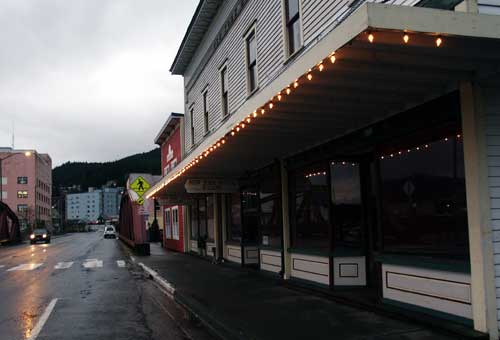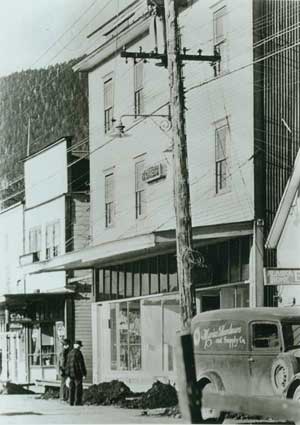 Rich history in a small package By June Allen November 22, 2003
 Donor: Mrs. Merle Stephens, Tongass Historical Society
The New York Hotel boasts a view of Thomas Basin, a busy small boat harbor. When the hotel went up in 1925, four or five years before the mouth of Ketchikan Creek was dredged to create the harbor, the hotel overlooked Ketchikan's famous tideflat ballpark, where crowds gathered to watch hard-fought baseball games that would end when the tide came in! In 1925 the new hotel's location just beyond the east entrance/exit of Creek Street - was on the "wrong side of the tracks." Only steps away was the nororious Creek Street red-light district whose girls were familiar to fishing fleets all along the Pacific Coast. The whole area from Bawden to the east edge of town was called Indian Town then, and was home not only to the tribes that had settled on either side of the creek but to the minority populations of Filipino, Chinese and Japanese. The new New York Hotel of 1925 was a transplant of the New York Café, a pioneer restaurant on the water side of Front Street, which dated back at least to 1903. That was the year that the Polk Directory listed Anthony "Tony" Ohashi as owner. Over the following years, other members of the extended Ohashi family came to Ketchikan from Japan, working at the downtown restaurent or building their own places on Stedman Street. Today's Ohashi store building, just up the street from the New York, is among the oldest buildings on the street. The late Komatsu ("Mama") Ohashi, in a 1993 interview for the Friends of the Library, said she remembered family stories about the old Front Street New York Café. She said that while the café served American food, the Ohashi family liked fish best - so they had a hole cut in the floor of the back room where they dropped lines and reeled in fish for their dinners! Then at some later point George and Yayoko Shimizu bought the New York Café
The town was booming in that decade called the Roaring '20s. The little city on Tongass Narrows was growing fast and it was more prosperous than it had ever been. In spite of the Territory's being so far removed from the big cities of the United States, Ketchikan was closely linked with them. Major newspapers were available in Ketchikan in two or three days. Telegraph lines brought urgent messages. Steamships brought rumors and predictions. Ketchikan enjoyed the latest movies in its three show houses. Some local ladies bobbed their hair and wore the latest fashions. And in 1925 youngsters practiced the steps of the Charleston in the halls of a brand new concrete schoolhouse on Grant Street hill. Down south in the 1920s, the nation was going through a period of general unrest, with fears of "anarchists" and "radicals," as well as what was considered the threat of women in short skirts and shorter hair. Newspapers reported that the Ku Klux Klan had begun harrassment of Catholics in the Midwest and on the East Coast. There were parents who were greatly concerned about the theory of evolution being taught in the schools - culminating with the Scopes trial, when Tennessee high school teacher John Scopes was found guilty of just that and fined $100. Women had gained the vote, and American Indians had been granted citizenship. Immigration was being sharply curtailed and quotas set for races and nationalities. There was a particular fear of what was called "the Yellow Peril," the proliferation of Asians in the country. It was a time in Ketchikan when city fathers saw a need to redesign and renovate the downtown area. One of the first steps was to ban Indians from meeting ships and selling curios on the docks. Minority businesses downtown were required to remove to Indian Town. Today such actions would be unthinkable, but back then it was a common practice to do just that in other waterfront cities, and Ketchikan followed suit. The Shimizus moved their café to its new buildiong site on Stedman Street, to be part of the new hotel they were building. The hotel's 18 tiny rooms were adequate for their mostly long-term residents. The Shimizus themselves were busy all day in the hotel, kitchen and café, and at night they retired to tiny loft-like sleeping quarters atop the kitchen's rock ledge that would many years later be pick-axed away. When their family grew, they built a small stairway to access just one of the second floor rooms for themselves. The late Jimmy Tatsuda remembered the Shimizu family well. George Simizu, the father, was "the hardest working man I ever saw," Tatsuda remembered. The family kept him moving. "He spent a great deal of time in his skiff, fishing, or hauling in beach logs and chopping wood to keep the hotel warm." The mother was a stern woman, he said, who ran the hotel with an iron hand. She was known to have held a resident logger's caulk boots hostage for past-due rent. Her husband George was drowned near Clover Pass while fishing, Tatsuda recalled, but there is no record of a burial in Bayview Cemetery to pinpoint the date of his death. The New York Hotel was built during Prohibition just steps away from the town's notorious red-light district, but no sporting women ever entertained in the New York Hotel and no liquor - legal or illegal - was ever served or sold there. And then on Dec. 7, 1941, came the Japanese attack on the United States military installations at Pearl Harbor. The United States decalred war on Japan and the Axis powers. There followed a period in America's history that is still debated today, concerning the evacuation of Japanese residents along the West Coast of Alaska, Washington, Oregon and California to internment camps inland in Idaho, Arizona and other locations. There was a genuine fear among Americans that in the event of an enemy invasion of Alaska and/or the West Coast, local Japanese - even U.S.-born and U.S. citizens - might join the invaders, or could be confused with the enemy. Ketchikan's Japanese were rounded up and transported to camps. Those in Ketchikan were luckier than most - neighbors cared for their properties and possessions until war's end when they returned them to the families. Many Japanese in California were not so lucky and lost everything. Over the postwar years various managers rented the New York Hotel's rooms and kept an eye on the property, which belonged eventually to the Shimizu daughters, who no longer lived in Ketchikan. The building fell into disrepair, and had a look of abandonment. The foundation sagged and veteran cab driver "Scotty" Knapp recalled that the floor of his room in the old hotel sloped so much that he felt like he'd slide down and out the window! That's the way the old building remained until the mid-1980s when a young man named Fred Ochsner fell in love with the New York Hotel. Fred Ochsner was a natural-born and trained craftsman who admired and appreciated the work of Ketchikan's early builders. In 1984 he had returned from work on the North Slope and taken a job working on the piling underpinnings of Dolly's House of Creek Street. Eash afternoon after work he'd pass the New York Hotel, shade his eyes and peer into the windows. He admired the façade of the building and walked around it as far as he could, examining every detail. Finally he located the Shimizu daughters, the owners, and made an offer. When the building was finally his in 1986, he examined every inch of it. And he ignored those who suggested in jest - and perhaps seriously - that he burn the place down and start over from scratch! He camped in a corner of one of the rooms to save time and money while he worked. His goal was to restore the building bit by bit and and save as much of the original as possible. First he emptied the rooms of furniture and all the things old buildings collect. What was in good condition was saved in storage; the rest was dumped.  Photo by Dick Kauffman
He stripped and saved all the doors. He saved and cleaned as many lighting fixtures as possible. Every scrap of salvageabale wood was saved and incorporated, somewhere. He studied the cornice and copied the dentils, those little blocks of wood that march along like decorative teeth. He studied the wiindows and windows in other buildings of the same era, copying their design, details that allow windows in a wet climate to sweat and drip without rotting them out. He reframed the building. He put in the bathrooms. He installed carpeting. He sanded and stained, painted and decorated and stayed with it through personal problems and the swiftly shrinking budgeted funds. The original "check-in desk" on the second floor remained in its original position but now has a washer and dryer hidden behind it. The job was herculean, but Ochsner stuck with it. When the the project was where he felt he'd accomplished his goal, his parents - Leo and Arlene Ochsner of Seattle - came north to join the project with broom, bucket and sander, as well as moral and financial support. His mother was in charge of bedding, curtains and furniture, all chosen with an eye as close to 1925 accuracy as possible. His father took on woodworking respponsibilities. As a family, they finished the project. Ketchikan was provided with a handsome and historic "new" small hotel. It took Fred Ochsner six years, start to finish, working day and night, seven days a week, alone, to complete his task. He is justly proud of it! He no longer lives in Ketchikan, but many people remember seeing him on scaffolding, rain or shine, sanding, painting, sweating - and accomplishing his goal. The hotel is a tribute to hard work, determination, and historical accuracy.
Today the hotel is owned by the Reeve family. It is a popular place for locals and a choice location for independent visitors.
june@sitnews.org
All rights reserved. Not to be reprinted in any form without the written permission of June Allen.
|
||||||||






